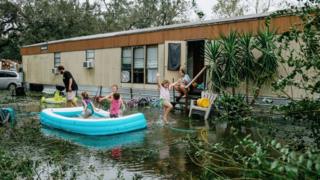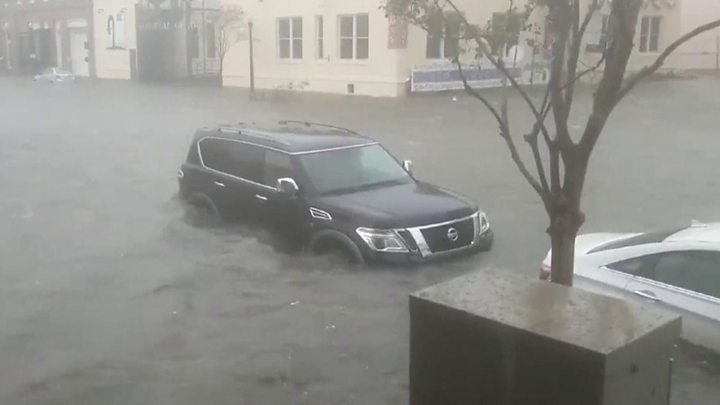This website uses cookies so that we can provide you with the best user experience possible. Cookie information is stored in your browser and performs functions such as recognising you when you return to our website and helping our team to understand which sections of the website you find most interesting and useful.
 Image copyright Getty Images
Image copyright Getty ImagesStorm Sally is bringing torrential rain and flooding to the Carolinas and Georgia, as it continues its path of destruction north from the US Gulf Coast.
It has already battered Florida and Alabama with rain and storm surges, downing power lines, turning roads into rivers and leaving homes submerged.
Coastal communities are now taking stock of the damage.
One person was killed, and hundreds of thousands are without power.
Besides the fatality reported in Orange Beach, Alabama, one person is also missing from the small coastal city in southwest Alabama, according to Mayor Tony Kennon.
"It was an unbelievably freaky right turn of a storm that none of us ever expected," he told the Washington Post.
Pensacola, Florida, 30m (48 km) east of Orange Beach, was also badly hit, with a loose barge bringing down part of the city's Bay Bridge.

Media playback is unsupported on your device
Downtown Pensacola was hit with up to 5ft of flooding and saw the highest storm surge on record. The storm brought "four months of rain in four hours" to the city, Pensacola fire chief Ginny Cranor told CNN.
Pictures show residents wading through waist-deep water, cars stranded in flooded streets, and homes entirely swamped by Wednesday's deluge.
In Gulf Shores, Alabama - near where Sandy first made landfall as a hurricane on Wednesday - the storm sheared off the face of a beachside apartment complex. And 50mi (80km) northwest in Mobile, Alabama, photos show the large steeple of El-Bethel Primitive Baptist Church toppled after the storm.
Sally hit Gulf Shores, Alabama, at 04:45 local time on Wednesday, with maximum wind speeds of 105mph (169 km/h).
According to the National Hurricane Center (NHC), Category 2 hurricanes have sustained winds of 96 to 110 mph. The NHC says a Category 2 storm's "extremely dangerous winds" usually cause damage to homes and shallowly rooted trees.
As the storm moved north from the coast, some 550,000 residents in affected areas were left in the dark on Wednesday night, according to local reports.
Now a post-tropical cyclone, the storm is expected to deposit up to 10in (25cm) of rain in Virginia and the Carolinas. It will likely cause widespread flash flooding, the NHC said on Thursday.
Maximum wind speeds have decreased to 30mph (45 km/h) as the storm moves northeast at a speed of about 21mph (33km/h).
Scattered tornadoes are also possible from Georgia into South and North Carolina into Thursday evening.
Sally is one of at least five storms in the Atlantic Ocean. Officials are running out of letters to name the hurricanes as they near the end of their annual alphabetic list.
Have you been affected by Hurricane Sally? Share your experiences by emailing haveyoursay@bbc.co.uk.
Please include a contact number if you are willing to speak to a BBC journalist. You can also get in touch in the following ways:
- WhatsApp: +44 7756 165803
- Tweet: @BBC_HaveYourSay
- Please read our terms & conditions and privacy policy
If you are reading this page and can't see the form you will need to visit the mobile version of the BBC website to submit your question or comment or you can email us at HaveYourSay@bbc.co.uk. Please include your name, age and location with any submission.



 Africana55 Radio
Africana55 Radio 
